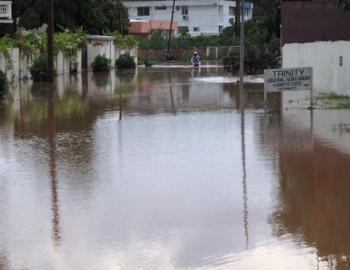GUIDE: What does it take to mainstream disaster risk management in key sectors?
GUIDE: What does it take to mainstream disaster risk management in key sectors?
Climate-related disasters are becoming more frequent and negatively impacting development progress across the world. People are already experiencing the impacts of climate change through slow onset changes, for example sea level rise and greater variability in the seasonality of rainfall, and through extreme weather events, particularly extremes of heat, rainfall and coastal storm surges. As the latest reports by the Intergovernment Panel on Climate Change tell us, greenhouse gases that have already been emitted mean that the world will experience several decades of climate change, regardless of current efforts to reduce emissions.
Actions towards development must be compatible with a changing climate. This requires each country to have a plan to avoid the losses and damages associated with extreme weather and to make disaster resilience central to economic and social policies. Mainstreaming disaster risk management within the policies and programmes of different sectors ensures that the effects of disasters are minimised. At the same time, it enables governments to ensure that these policies and programmes do not put people at risk.
This CDKN guide, What does it take to mainstream disaster risk management in key sectors? by Amy Kirbyshire and Aditya Bahadur at the Overseas Development Institute, together with Dina Khan of LEAD and Mihir Bhatt of the All India Disaster Management Institute, draws on the experience of CDKN’s programmes on climate-related disaster risk management (DRM) within the context of climate compatible development. We explore why mainstreaming DRM into development policy has had widely varying results between countries. In doing so, we attempt to delve beneath the surface of mainstreaming and identify the ways forward for integrating short- and long-term considerations for disaster risk reduction in important development sectors.
We demonstrate that effective mainstreaming requires a supportive policy environment, leadership, knowledge of the relevant risks, risk management techniques that are appropriate to each context, consistent financing and innovation. We draw on empirical examples and relevant literature to suggest how to achieve these elements and presents a clear way forward for governments seeking to mainstream disaster risk across different sectors.
The key messages for governments are:
1. Focus on amending and altering institutional practices:
- Reduce compartmentalisation, initially through small-scale strategic coordination.
- Include mainstreaming in the remit of key officials.
- Organise training for staff charged with planning functions in ministries.
- Create incentives for action on mainstreaming.
2. Develop enhanced processes for understanding risk:
- Ensure that the planning of policy processes is open to diverse stakeholders.
- Mandate risk evaluation, including through legislation.
- Promote risk evaluation methods that are not data intensive.
- Work closely with people who will use the data emerging from risk assessments.
- Access and share risk assessment tools.
- If needed, look at the feasibility of establishing technical bodies for risk assessment.
3. Acknowledge that mainstreaming processes are highly political:
- Give the intended beneficiaries of mainstreaming processes a voice.
- Use the available tools to map political risks.
- Build political momentum by understanding the costs and benefits of mainstreaming.
4. Build effective partnerships:
- Explore vertical partnerships between higher and lower levels of government for conducting risk analysis.
- Shape business opportunities for private sector involvement in risk management.
- Enhance interactions between staff in sectors and organisations with experience in mainstreaming.



